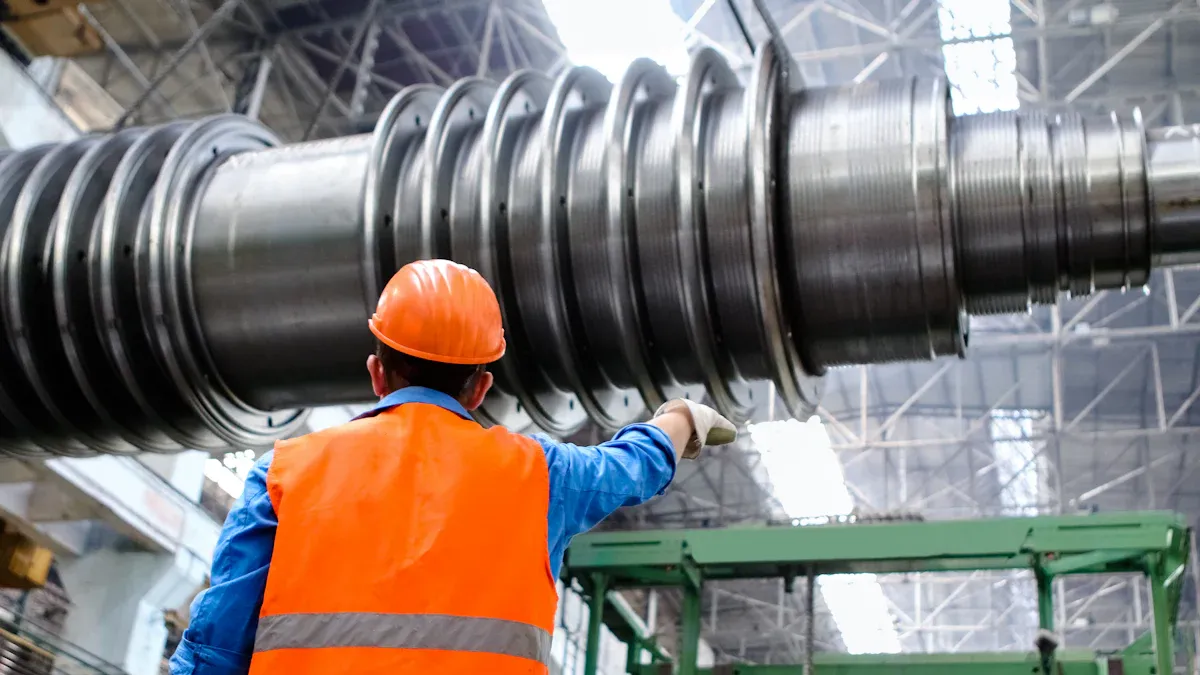How PET Heat Shrink Tubing Achieves High Radial Strength

PET heat shrink tubing for high radial strength combines advanced material properties with precision engineering. Its high tensile strength resists deformation under stress, while its durability ensures long-term performance. The manufacturing process aligns molecular structures to enhance radial strength. These qualities make it essential for medical devices that demand reliability and biocompatibility. Applications such as catheters, guidewires, and surgical tools benefit from its robust design.
Key Takeaways
PET heat shrink tubing is strong and does not bend easily.
It is safe to use with the human body, so it works well for medical tools like catheters and guidewires.
The way it is made lines up its molecules, which makes it stronger and better overall.
Careful checks make sure it works the same every time and meets safety rules.
PET heat shrink tubing can be used in many ways, both for medical and other uses, because it protects and insulates well.
Understanding PET Heat Shrink Tubing
What Is PET Heat Shrink Tubing?
PET heat shrink tubing is a specialized material designed to provide a tight, protective covering when exposed to heat. Made from polyethylene terephthalate (PET), this tubing shrinks radially to conform to the shape of the object it encases. Its unique properties make it ideal for applications requiring precision, durability, and reliability. In the medical field, it plays a critical role in protecting devices like catheters and guidewires, ensuring they perform effectively under demanding conditions.
The construction and performance of PET heat shrink tubing adhere to strict industry standards. For example:
UL/CSA 224 outlines requirements for electrical insulation tubing, including flexibility and oil resistance.
AMS-DTL-23053 evaluates heat shrinkable tubing for specific gravity and fungus resistance.
3-A Sanitary Standards ensure materials meet public health safety through independent laboratory testing.
These standards guarantee that PET heat shrink tubing meets the rigorous demands of medical and industrial applications.
Key Material Properties of PET
PET exhibits several key material properties that contribute to the exceptional performance of its heat shrink tubing. These include:
Resistance to cleaning agents, ensuring longevity in medical environments.
Endurance to UV radiation, preventing degradation over time.
Structural integrity during sterilization, supporting the safety of medical devices.
Excellent tensile strength, providing durability under mechanical stress.
Resistance to moisture and chemicals, enhancing performance in healthcare settings.
Clarity and flexibility post-sterilization, preserving visibility and usability in sterile environments.
These attributes make PET heat shrink tubing a reliable choice for applications requiring high radial strength and durability.
Biocompatibility and Its Importance in Medical Applications
Biocompatibility is a critical factor in the design of medical devices. PET heat shrink tubing excels in this area, ensuring it can safely interact with biological tissues and fluids without causing adverse reactions. This property is essential for applications like catheters and guidewires, where the tubing comes into direct contact with the human body.
The biocompatibility of PET heat shrink tubing also supports its use in sterilized environments. Its ability to maintain structural integrity and clarity after sterilization ensures that medical professionals can rely on it for precision and safety. This combination of biocompatibility and durability makes PET heat shrink tubing indispensable in modern healthcare.
The Manufacturing Process Behind High Radial Strength

Tube Drawing and Heat Shrinking Techniques
The manufacturing process of PET heat shrink tubing for high radial strength begins with tube drawing and heat shrinking techniques. These methods play a pivotal role in enhancing the tubing's mechanical properties. Tube drawing involves pulling the PET material through a die to achieve the desired dimensions and molecular alignment. This step increases the tubing's tensile strength and ensures uniformity in its structure.
Heat shrinking follows the drawing process. During this stage, the tubing is heated to a specific temperature, causing it to shrink radially. This process not only enhances the tubing's compressive strength but also ensures a snug fit around the object it encases. For example, in medical applications, this precision is critical for devices like catheters and guidewires, where reliability and biocompatible applications are essential.
The benefits of these techniques are supported by engineering research. A study on PET tubing manufacturing highlights the following steps:
Process Step | Description |
|---|---|
Extrusion | Tubes are extruded using a Killion extruder with precise parameters. |
Die Drawing | Tubes are die-drawn to align molecular structures, improving strength. |
Heat Treatment | Tubes are heated to induce shape memory and enhance compressive strength. |
Final Product | High-performance PET tubing capable of withstanding high mechanical loads. |
These steps ensure the production of high-quality PET tubing with exceptional radial strength, making it suitable for demanding applications.
Role of Molecular Orientation in Strength Enhancement
Molecular orientation is a key factor in achieving high radial strength in PET heat shrink tubing. During the manufacturing process, the molecules within the PET material are aligned through mechanical and thermal treatments. This alignment enhances the tubing's structural integrity, allowing it to withstand significant mechanical stress without deformation.
Cold working, a process that involves deforming the material at low temperatures, refines the microstructure of PET. This step increases the tubing's tensile strength and durability. Heat treatment follows, stabilizing the molecular orientation and ensuring the tubing retains its shape under stress. For instance, cold working and heat treatment in nitinol tubing manufacturing have shown to improve superelasticity and shape memory, which are critical for maintaining structural integrity.
The impact of molecular orientation can be quantified through production metrics:
Metric | Result |
|---|---|
Tensile Strength | |
Local Strains | Up to 6% |
Cycles to Failure | Up to 10⁷ cycles |
Strain Amplitudes | 0.5% to 2.9% |
Cold Work Percentage | 20–30% |
These metrics demonstrate how molecular orientation contributes to the exceptional performance of PET heat shrink tubing for high radial strength.
Quality Control for Consistent Performance
Quality control is essential to ensure the consistent performance of PET heat shrink tubing. Manufacturers implement rigorous inspection protocols to verify that each batch meets precise specifications. Advanced measurement systems assess parameters such as inner diameter, outer diameter, wall thickness, and ovality. These measurements ensure that the tubing maintains its structural integrity and biocompatibility.
Key benchmarks in quality control include material quality, dimensional tolerances, and mechanical stability. Tools like the BenchLinc ID/OD/Wall Measurement System use laser micrometer technology to provide accurate and fast measurements. Comprehensive testing methods, such as tensile performance tests and thermal expansion analysis, confirm the tubing's durability and flexibility. These tests ensure that the tubing can withstand mechanical stress and environmental factors.
For example, PET heat shrink tubing undergoes extensive testing to ensure it meets the demands of biocompatible applications. This includes verifying its ability to maintain clarity and strength after sterilization. Such rigorous quality control measures guarantee the production of high-quality PET tubing that performs reliably in critical applications.
Benefits of PET Heat Shrink Tubing for High Radial Strength
Durability and Resistance to Wear
PET heat shrink tubing offers exceptional durability, making it ideal for high-performance applications in demanding environments. Its high tensile strength and chemical resistance allow it to withstand mechanical stress, abrasion, and exposure to harsh cleaning agents. These qualities ensure that the tubing maintains its structural integrity over time, even in rigorous medical and industrial applications.
The durability of PET heat shrink tubing also extends to its ability to resist wear caused by repeated use. For example, in medical devices like catheters and guidewires, the tubing must endure constant movement and friction without compromising its performance. This resilience reduces the risk of device failure, enhancing patient safety and extending the lifespan of the equipment.
Additionally, PET tubing's durability and flexibility make it suitable for applications requiring precision and reliability. Its ability to maintain clarity and strength after sterilization further underscores its value in healthcare settings, where consistent performance is critical.
Compatibility with Sterilization Processes
PET heat shrink tubing demonstrates remarkable compatibility with various sterilization methods, a crucial factor for medical-grade applications. Its ability to withstand high temperatures, ionizing radiation, and chemical exposure ensures that it remains effective and safe for use after sterilization.
Sterilization Method | Compatibility Insights |
|---|---|
Autoclaving | Must withstand steam sterilization at 121–135°C without performance degradation. |
Gamma Radiation | Requires materials resistant to ionizing radiation, with formulations avoiding free radical generation. |
Ethylene Oxide | Must meet stricter thermal and chemical resistance thresholds, with enhanced crystallinity to prevent deformation. |
Hydrogen Peroxide Plasma | Unmodified PET shows reduced tensile strength after multiple cycles, necessitating blends with stabilizers. |
Clinical validation plays a vital role in ensuring the tubing's stability under sterilization. Manufacturers often conduct extensive testing, which can take 12–18 months, to confirm that the tubing meets regulatory standards and maintains its quality. These rigorous processes ensure that PET heat shrink tubing complies with certifications and remains reliable for medical applications.
The ability to endure multiple sterilization cycles without degradation highlights the tubing's durability and flexibility. This makes it a preferred choice for healthcare professionals who rely on high-performance applications to deliver safe and effective patient care.
High Dielectric Strength for Electrical Insulation
PET heat shrink tubing provides excellent electrical insulation, thanks to its high dielectric strength, which exceeds 4,000 V/mil. This property ensures that the tubing can protect sensitive components from electrical interference, making it indispensable for applications requiring robust insulation.
The material's ability to withstand significant electrical stress enhances the reliability and safety of medical devices. For instance, in surgical instruments and compact medical devices, PET tubing prevents electrical malfunctions that could compromise patient safety. Its chemical resistance further supports its performance in environments where exposure to cleaning agents and sterilization processes is common.
By combining high dielectric strength with durability, PET heat shrink tubing ensures consistent performance in critical applications. This makes it a trusted solution for engineers and manufacturers seeking reliable materials for high-performance applications in the medical field.
Applications in the Medical Field

Catheters and Guidewires
PET heat shrink tubing plays a critical role in the construction of catheters and guidewires. Its high radial strength and biocompatibility ensure these devices meet the stringent demands of medical applications. The tubing provides reliable insulation and protection for the delicate wires and components within catheters, safeguarding their performance during procedures. Its ability to conform tightly to surfaces enhances the reliability of these devices, ensuring patient safety in critical situations.
The global market for ultra-thin PET heat shrink tubing highlights its importance in this field. Key manufacturers like Nordson MEDICAL and AccuPath focus on innovations that improve shrink ratio precision and biocompatibility. These advancements align with the growing demand for reliable medical devices in regions such as North America and Europe, while Asia-Pacific experiences rapid growth due to increased healthcare investments. Regulatory requirements further emphasize the need for rigorous testing to ensure safety and reliability in these applications.
Surgical Instruments and Tools
Surgical instruments and tools benefit significantly from the use of PET heat shrink tubing. Its durability and insulation properties enhance the safety and reliability of these devices. The tubing provides a protective layer that resists wear and exposure to sterilization processes, ensuring consistent performance in demanding surgical environments. Its high dielectric strength also prevents electrical malfunctions, which could compromise patient safety during procedures.
Compliance with medical standards such as ISO 10993-1:2018 and FDA regulations underscores the tubing's suitability for surgical applications. These standards require thorough evaluations of material safety, sterilization compatibility, and performance. For example, CE Marking under EU Medical Device Regulation mandates expanded clinical evaluations for diagnostic devices, ensuring their safety and reliability. PET tubing meets these stringent requirements, making it an indispensable component in surgical tools.
Standard | Description |
|---|---|
ISO 10993-1:2018 | Framework for biological evaluation of medical devices and safety assessment. |
FDA Regulations | Documentation of material sourcing and sterilization compatibility. |
CE Marking | Compliance with EU regulations for expanded clinical evaluations. |
Compact and Specialized Medical Devices
Compact and specialized medical devices rely on PET heat shrink tubing for protection and performance. Its ability to provide precise insulation and protection for small, intricate components makes it ideal for these applications. The tubing ensures that these devices maintain their reliability and safety, even in challenging environments. Its compatibility with sterilization processes further enhances its value in medical-grade standards.
For example, PET tubing is commonly used in diagnostic devices, where its insulation properties prevent electrical interference. Its high tensile strength and resistance to wear ensure long-term performance, reducing the risk of device failure. These qualities make PET heat shrink tubing a trusted choice for manufacturers seeking to develop innovative medical devices that prioritize patient safety and reliability.
PET heat shrink tubing achieves high radial strength through its advanced material properties and precise manufacturing techniques. Its durability and biocompatibility make it a vital component in medical device innovation. These qualities ensure that devices like catheters, guidewires, and surgical tools perform reliably under demanding conditions.
Key Takeaway: PET heat shrink tubing combines strength, safety, and adaptability, making it indispensable for healthcare applications. Its role in improving patient outcomes highlights its importance in modern medical technology.
By meeting stringent industry standards, PET tubing continues to support the development of safe and effective medical solutions for healthcare providers and patients alike.
FAQ
What makes PET heat shrink tubing unique compared to other materials?
PET heat shrink tubing stands out due to its high tensile strength, biocompatibility, and resistance to chemicals and sterilization processes. These properties make it ideal for medical applications requiring durability and precision.
Can PET heat shrink tubing be used in non-medical applications?
Yes, PET heat shrink tubing is versatile. It is used in industries like electronics and aerospace for insulation and protection. Its high dielectric strength and durability make it suitable for demanding environments.
How does PET tubing maintain its performance after sterilization?
PET tubing resists deformation and degradation during sterilization. Its molecular structure ensures stability under high temperatures, radiation, and chemical exposure, making it reliable for repeated use in sterile environments.
Is PET heat shrink tubing environmentally friendly?
PET is recyclable, which makes it more sustainable than many alternatives. However, its environmental impact depends on proper recycling practices and the specific application.
What factors should be considered when selecting PET heat shrink tubing?
Key factors include the tubing's shrink ratio, wall thickness, and compatibility with sterilization methods. Application-specific requirements, such as biocompatibility or electrical insulation, should also guide the selection process.
Tip: Consult with manufacturers to ensure the tubing meets your specific needs.
See Also
Essential Insights on PET Heat Shrink Tubing for Electronics
Applications of Heat Shrink Tubing for Electrical Wire Insulation
Comparing Medical and Industrial Grade Heat Shrink Tubing
A Simple Guide to FEP Autoclavable Heat Shrink Tubing
The Importance of Ultra-Thin PET Heat Shrink Tubing in Medicine

